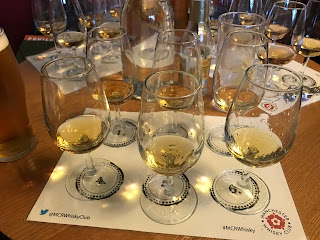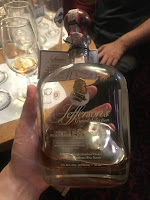 |
| The full line-up |
Club member Dan led a tasting for the first time in November, and he certainly chose an original theme: whisky from TV and the movies, aka Netflix and Distil.
 |
| Johnnie Walker Green |
It's billed as a blend of whiskies from the four main distilling areas of Scotland. And this was very drinkable indeed. Comments from the floor included "very drinkable" along with "pleasant" and "very surprised". There was a little bitterness about it at first, but that went, with a finish that was quite long and spicy instead. This retails for about the £35 or £40 mark, and it's decent value at that price. It's 43%.
 |
| Hibiki Harmony |
This is another blend, this time of both malt and grain whiskies. And it really does smell fantastic, with a honeyed sweetness. It tastes nice too, with a bit of sweetness on the palate as well, giving us a taste that some people likened to the mid point of a Speyside and a bourbon. It's £65 and is also 43%.
 |
| Old Forester Statesman |
This again was a very drinkable dram, with definite hints of citrus and spiciness. It did have a bit of an alcoholic taste to it though, which seemed to put a few members off, at least in comparison to the whiskies we'd already had. This is £59 and is 47.5%.
 |
| Knockando 18yo |
And we moved straight on with an 18yo Knockando, and a thoroughly enjoyable extract of the most famous whisky story ever told, Whisky Galore. I managed not to write down exactly what the connection between Knockando and Whisky Galore actually was, but it's certainly true to say that bottles of distilleries from all over Scotland were famously washed up on Eriskay, thinly fictionalised by Compton Mackenzie in his novel and the subsequent movie.
The whisky, matured in sherry casks, was again highly drinkable, sweet and sticky, with a hint of candy floss about it. It's again about the £60 mark if you can find a bottle, and it's 43%.
 |
| Lagavulin 8yo |
The 8yo first hit shelves in 2016 as a sort of limited edition thing, but as with a lot of limited editions which find a market, it's now become part of the distillery's core range. Again, a lovely dram this, with the initial burst of peat on the palate giving way to various other flavours (the tasting notes suggest kippers). It's £51 which puts it roughly on a par with the 16 for price, and it's 48%.
 |
| SMWS The Lady Varnishes |
The particular bottling was called The Lady Varnishes, and came from the Strathclyde grain distillery in the Gorbals. All I've written down is "this is lovely" which is not the most detailed tasting note in club history. Notes elsewhere suggest hints of pear, cinnamon, oak, and much else besides. Anyway, it is very pleasant. It's £125 and is 58.4% although there were only ever just over 250 bottles produced, so good luck finding one.
That brought us to the dram of the night voting, and five of the six whiskies got at least some support (sorry Old Forester), but with nine votes it was The Lady Varnishes which took the night, one ahead of Hibiki and two clear of Knockando.
Thank you to Dan for putting together such an interesting and entertaining evening, to all at the Britons Protection for hosting us again, and to club members old and new for attending.

















































